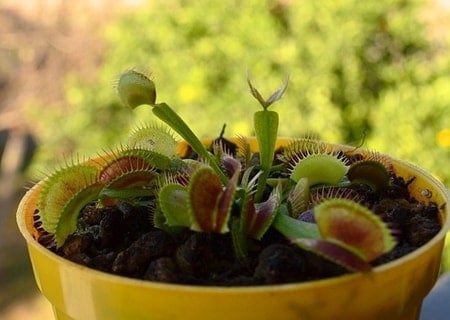When Venus flytraps go dormant, their needs change. They require less water, they do not need to capture bugs, and their light exposure requirement becomes more lenient.
Dormant Venus flytraps living at close to freezing temperatures do not require light, but they are commonly exposed to it. Outdoor plants have exposure to natural sunlight, which guides them through entering and exiting dormancy. For indoor plants, it is recommended to provide light during dormancy.
In this short article, I will teach you how much light do dormant Venus flytraps need depending on each particular situation.
Indoor vs. Outdoor Light Requirements During Dormancy
Outdoor Venus flytraps undergoing dormancy can continue to receive natural light. The sunlight during the winter won’t harm them. On the contrary, light exposure will help them stay dormant and eventually exit dormancy as the climate warms up and the days become longer.
Dormant Venus flytraps living under freezing temperatures (30F range) do not need light to survive. At such low temperatures, Venus flytraps are entirely inactive. Their growth is stagnant, and they are in hibernation mode. Still, there is no harm for Venus flytraps to receive sunlight during dormancy. Many areas have cold winters, which characterize by bright days.
Indoor Venus flytraps should also experience dormancy. Most people place them in an unheated porch, garage, or basement to make them go dormant in the winter. Even though dormant Venus flytraps do not require lighting when they remain at temperatures close to freezing, providing lighting for indoor Venus flytraps is a safer alternative.
Temperature changes in indoor locations can bring Venus flytraps out of dormancy. If Venus flytraps are starting to exit dormancy or exit dormancy completely, they need plenty of light to remain healthy.
In most cases, it is not safe to place a Venus flytrap in a cold and dark indoor location during dormancy unless there are no significant temperature fluctuations.
I recommend using artificial lighting to ensure Venus flytraps remain healthy. You can employ fluorescent or LED grow light. Both types of grow lights are inexpensive and practical options. When choosing fluorescent bulbs, pick cool colors that promote growth. I have used this small LED plant light (which costs less than $30) to grow some of my Venus flytraps, and they are thriving.
When employing artificial lights for dormant Venus flytraps, you must ensure their light exposure is appropriate. During the growing season, 12-14 hours of light exposure are optimal. But, during dormancy, such extended periods of light can confuse plants and force them to exit dormancy. Set the daily light exposure to a shorter daily light interval, such as 8-10 hours.
How to Reintroduce Venus Flytraps to Lighting
In the outdoors, Venus flytraps enter and exit dormancy naturally. As the temperatures drop, they enter dormancy, and by the end of winter, they exit dormancy.
If your Venus flytrap lives outdoors, the process of entering and exiting dormancy won’t require much planning. As long as low temperatures drop below 45F for a couple of months, your Venus flytrap will experience dormancy.
When the temperatures start to rise and days get longer at the end of winter, Venus flytrap will exit dormancy. Let outdoor plants exit dormancy naturally. Avoid changing their location until they have exited dormancy to avoid any type of shock.
Indoor Venus flytraps with access to sunlight can also exit dormancy naturally.
Indoor flytraps exposed to artificial lighting will require a little extra planning. Those plants need to be reintroduced to warmer weather and more lighting slowly.
You can increase the number of hours the artificial light is powered on to mimic the outdoors. For example, you can add an extra daily hour or two of light a week (up to 14-16) until your Venus flytrap exits dormancy. Then, your Venus flytrap can be moved outdoors or remain indoors, as long as it has access to enough lighting for the growing season.
Growing Venus flytraps indoors is possible, but it is much more challenging than growing them outdoors. This guide can help you grow Venus flytraps indoors with great success: Venus Flytrap Indoor Care Guide with Downloadable Care Sheet.
Other Care Considerations for Dormant Venus Flytraps
The list below outlines the most important care considerations for Venus flytraps during dormancy. Make sure to review these items before your plant’s first dormancy.
- Continue to water your plant often, but be ready to lower the watering frequency. Dormant Venus flytraps consume less water.
- Do not fertilize Venus flytraps.
- Avoid feeding your Venus flytrap during this period. If it catches a bug on its own, that is ok. But, do not feed it manually.
- Carefully trim and remove dead leaves as they wither.
- Repotting at the end of dormancy is a common and useful practice.
I hope this article helped you learn about Venus flytraps and their dormancy period. For more information on Venus flytrap care, I would like to share this article with you: Ultimate Venus Flytrap Care Guide – Free Care Sheet Included.


